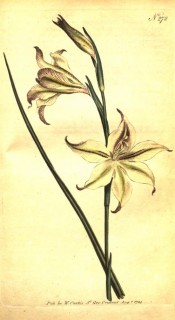Gladiolus tristis L.
Half-hardy cormous perennial with long, very narrow leaves, often twisted at the top, and spikes of up to 20 open funnel-shaped, strongly scented, pale yellow or creamy-white flowers, flushed or dotted mauve, red, brown or purple. Usually found in marshy sites and grows well at pond edges provided it can be kept dry when dormant. To 150cm. [RHSE, Hortus, CECB].
Horticultural & Botanical History
‘Linnaeus gave to this species of Gladiolus the name of tristis, from the colour of its flowers, which however possess scarcely sufficient of the sombre to justify the appellation; still less so if they vary in the manner represented in Trew’s Ehret, where they are painted in gay and lively colours: in the specimens we have seen, the blossoms have been of a sulphur colour, shaded in parts with very fine pencillings, especially on the under side: most authors describe the flowering stems as producing only two flowers, Linnaeus has observed that they sometimes produce many, we have seen them do so where the plant has grown in perfection; in their expansion, which usually takes place in April and May, they give forth a most agreeable fragrance.
It is a native of the Cape, and other parts of Africa; was cultivated by Mr. Miller, and flowered in the Chelfea Garden in the year 1745. Ait. Kew.
The leaves which so characteristically distinguish this species are highly deserving of notice, instances of such rarely occur; as the bulbs produce numerous offsets, the plant is propagated by them without difficulty, and requires the same treatment as other Cape bulbs.’ [BM t.272/1794]. ‘In the evening and night it diffuses a considerable degree of fragrance, like that of the common garden pink, but in the day-time is destitute of all scent.’ [BM t.1098/1808].
Introduced to Britain in 1745. [JD].
History at Camden Park
Received per ‘Sovereign’ February 1831 [MP A2948-2] and listed in all published catalogues [B.167/1843]. Used extensively in hybridising by Bidwill and Macarthur.
Notes
Gladiolus tristis Herb.Linn. ex Baker (1877) = Gladiolus grandis Thunb., a synonym of Gladiolus liliaceus Houtt. which see.
Gladiolus tristis Thunb. (c.1800) = Gladiolus trichonemifolius Ker-Gawl. which see.
Published Oct 28, 2009 - 09:33 AM | Last updated Jul 23, 2010 - 12:05 PM
| Family | Iridaceae |
|---|---|
| Category | |
| Region of origin | South Africa, Cape district |
| Synonyms | |
| Common Name | Marsh Afrikaner |
| Name in the Camden Park Record | Gladiolus tristis |
| Confidence level | high |


